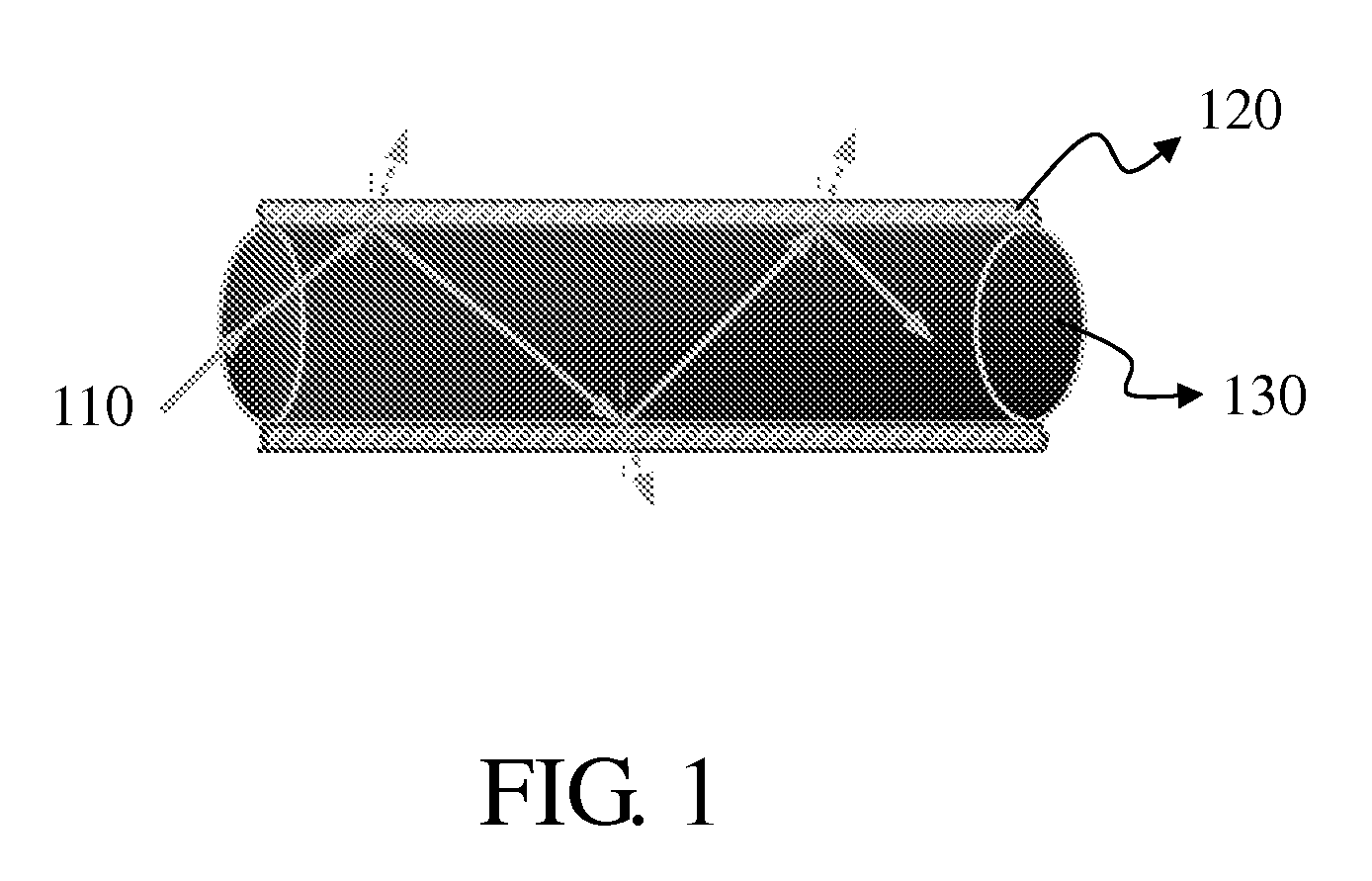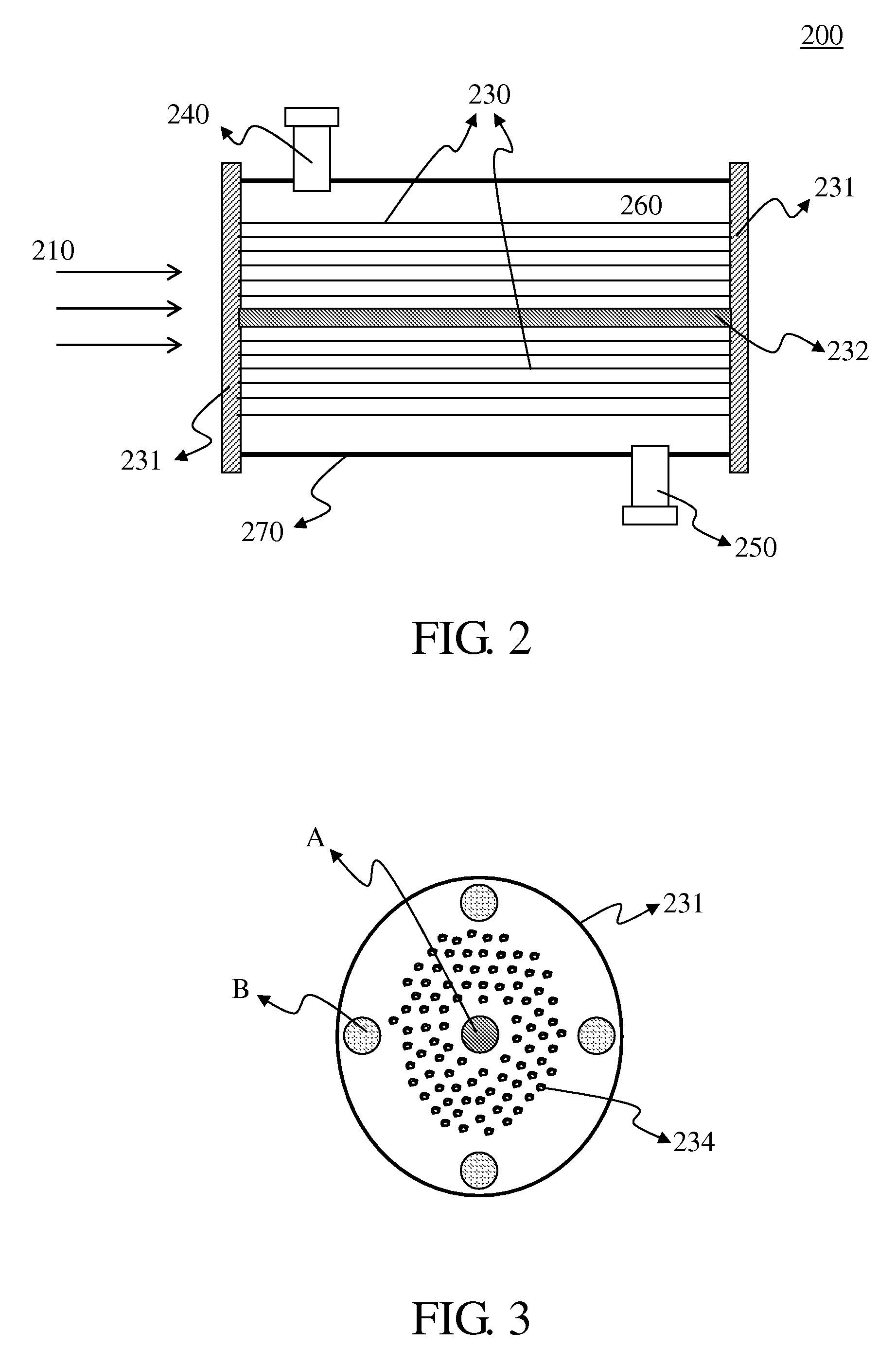Optical Fiber Photocatalytic Reactor And Process For The Decomposition Of Nitrogen Oxide Using Said Reactor
a technology of nitrogen oxide and photocatalytic reactor, which is applied in the direction of physical/chemical process catalyst, separation process, organic chemistry, etc., can solve the problems of high conversion rate of methods, severe toxic photochemical smog, and low conversion rate of methods
- Summary
- Abstract
- Description
- Claims
- Application Information
AI Technical Summary
Problems solved by technology
Method used
Image
Examples
example 1
The Preparation of a Photocatalyst
[0040]In this example, the following three types of photocatalyst were prepared: TiO2, α-Fe2O3, and ZnO. The TiO2 photocatalyst was prepared by via a thermal hydrolysis method, illustrated in the following steps. First, metal Pt was dissolved in advance in a 0.1 M aqueous nitric acid solution at a ratio of 1.0%, to which 17 mL titanium tetrabutoxide was slowly added. Upon completion of the addition of the titanium tetrabutoxide, the solution was heated to 80° C. and maintained at this temperature for 8 hours. The white colloid was dried in an oven at 80° C. for 24 hours. The resulting white solid material was calcined in a furnace at 500° C. Regarding the ZnO photocatalyst, commercially available powder was directly adopted. On the other hand, the α-Fe2O3 photocatalyst was synthesized via sol-gel method. In particular, isopropanol and iron nitrate (20 mmol) reacted for 20 minutes to form an α-Fe2O3 precursor solution, to which a thickener polyethyl...
example 2
The Preparation of Optical Fibers Coated with a Photocatalyst
[0041]The preparation of the optical fibers coated with a photocatalyst was accomplished by adhering the white colloid obtained from Example 1 onto quartz optical fibers wherein the polymeric protection film had been removed from the surfaces. The method used was a dip coating process. Specifically, the optical fiber was thermally treated at 500° C. to remove the polymeric protection film on the surface, washed with an aqueous NaOH solution then alternately cleansed with water and dried. Next, the white colloid was placed in a container, and the optical fiber was dipped for 5 minutes. Thereafter, the optical fiber was pulled out with a speed of 3 cm / min, to obtain an optical fiber with a photocatalyst precursor adhered uniformly thereon. The resulting optical fiber was dried at 80° C. for 20 to 24 hours, and then was calcined at 500° C. to 700° C. in a furnace for 5 hours to become photocatalyst film on optical fiber.
example 3
Continuous Photocatalytic Reaction (with CH4 as Reducing Agent)
[0042]Hundreds of optical fibers with a TiO2 photocatalyst coating thereon obtained in Example 2 were fixed inside the reactor on the stainless steel shelves. A He stream was introduced through the reactor with a flow rate of 20 ml / min for one hour to purge the impurities therein. Subsequently, a CH4 stream with a 99% concentration level was introduced into the reactor under a flow rate of 60 ml / min for one hour, so that CH4 was adsorbed onto the surface of the photocatalyst. Finally, a 50 ppm nitrogen oxide stream was introduced into the reactor with a residence time of 60 minutes, followed by a resumed CH4 gas supply of a 99% concentration level with a residence time of 120 minutes. The light was transmitted into the reactor through optical fibers to activate the photocatalytic reaction using a metal halide lamp as the light source. Exhaust gas from the reactor outlet was delivered to a nitrogen oxide analyzer for the...
PUM
| Property | Measurement | Unit |
|---|---|---|
| temperature | aaaaa | aaaaa |
| temperature | aaaaa | aaaaa |
| temperature | aaaaa | aaaaa |
Abstract
Description
Claims
Application Information
 Login to View More
Login to View More - R&D
- Intellectual Property
- Life Sciences
- Materials
- Tech Scout
- Unparalleled Data Quality
- Higher Quality Content
- 60% Fewer Hallucinations
Browse by: Latest US Patents, China's latest patents, Technical Efficacy Thesaurus, Application Domain, Technology Topic, Popular Technical Reports.
© 2025 PatSnap. All rights reserved.Legal|Privacy policy|Modern Slavery Act Transparency Statement|Sitemap|About US| Contact US: help@patsnap.com



